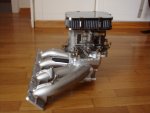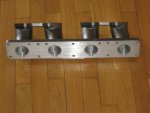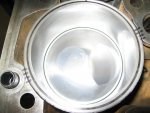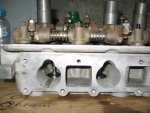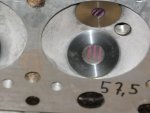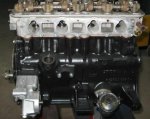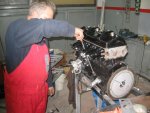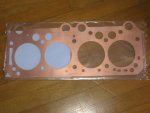No, the 404 KF and 1.8 liter 504 KF was not. I have a 1.8 liter KF from an early somewhere, I will dig it up and post a photo. The vacuum operation was introduced with the 2 liter 504 models in 1970 and improved fuel efficiency and throttle response. As a point of interest, the KF used in BMW 2002 was also NOT vacuum operated.Wait.. not vacuum operated... I thought be design all Kugelfischer injection was.?

You are using an out of date browser. It may not display this or other websites correctly.
You should upgrade or use an alternative browser.
You should upgrade or use an alternative browser.
Peugeot 504 marathon rally car build
- Thread starter ThanosK
- Start date
Hi Thanos
Thanks so much for letting us know of your amazing projects and the beautifully detailed reports of what you are doing, they certainly reflect your passion and commitment to rallying Peugeots. As a long time Peugeot lover, particularly some of the older ones, I really enjoyed and was encouraged by your efforts, keep up the good work, I look forward to hearing how it all goes in the rallies.
Regards
Neil
Thanks so much for letting us know of your amazing projects and the beautifully detailed reports of what you are doing, they certainly reflect your passion and commitment to rallying Peugeots. As a long time Peugeot lover, particularly some of the older ones, I really enjoyed and was encouraged by your efforts, keep up the good work, I look forward to hearing how it all goes in the rallies.
Regards
Neil
I got a lot of email and pm questions about the source for the intake manifolds and the performance differences between the DCOE and Argentinean manifolds. The DCOE manifolds for the twin Webers I sourced in Greece, they were custom-made by John Palmos: motorman253gr@yahoo.com
He has sold a few dozen of them to AFers who have used them for both DCOE's and QTB's.
The Argentinean manifold came from OZ, I traded an AFer a DCOE manifold for it.
The low compression engine with the Argentinean manifold was built to cross Mongolia in the Peking to Paris as the fuel there is around 80 octane. A cam with a lot of overlap was custom designed so cylinder pressures stayed at around 140 psi. A twin IDF carb was used with an Argentinean manifold instead of the twin DCOE's (and a DCOE manifold) to improve the lack-luster low end torque of the low compression engine. (Twin DCOE's give more high rpm power, but lower low rpm torque than the single twin barrel IDF.) Fueling and ignition timing were tricky, but in two days Palmos had it running like a top. The plan was to ship the car to China for the start of the Peking to Paris with this low compression engine and the single IDF, and ship the second engine (the one with the twin DCOE's, now on the car) to a rally stop near the Mongolia Siberia boarder, then change the engine (and take the opportunity to change the clutch as well). Good quality fuel would be available for the rest of the trip and the extra power (35 bhp) would come in handy, especially since we wanted to give these Aussies with their big V8 a run for their money . It sounds excessive, but freight is reasonable, and it takes less that four hours for the engine swap, since everything would be bolted on already and ready to connect to the extractors, the fuel line, and the coil. We were planning this like a military campaign, as our aim was to win the event outright. Now we will have to wait until 2019 for that
. It sounds excessive, but freight is reasonable, and it takes less that four hours for the engine swap, since everything would be bolted on already and ready to connect to the extractors, the fuel line, and the coil. We were planning this like a military campaign, as our aim was to win the event outright. Now we will have to wait until 2019 for that  as the Peking to Paris takes place every three years.
as the Peking to Paris takes place every three years.
He has sold a few dozen of them to AFers who have used them for both DCOE's and QTB's.
The Argentinean manifold came from OZ, I traded an AFer a DCOE manifold for it.
The low compression engine with the Argentinean manifold was built to cross Mongolia in the Peking to Paris as the fuel there is around 80 octane. A cam with a lot of overlap was custom designed so cylinder pressures stayed at around 140 psi. A twin IDF carb was used with an Argentinean manifold instead of the twin DCOE's (and a DCOE manifold) to improve the lack-luster low end torque of the low compression engine. (Twin DCOE's give more high rpm power, but lower low rpm torque than the single twin barrel IDF.) Fueling and ignition timing were tricky, but in two days Palmos had it running like a top. The plan was to ship the car to China for the start of the Peking to Paris with this low compression engine and the single IDF, and ship the second engine (the one with the twin DCOE's, now on the car) to a rally stop near the Mongolia Siberia boarder, then change the engine (and take the opportunity to change the clutch as well). Good quality fuel would be available for the rest of the trip and the extra power (35 bhp) would come in handy, especially since we wanted to give these Aussies with their big V8 a run for their money
Attachments
Last edited:
...I love the paint job!
Thanks, I will tell my son! When we bought the car the burgundy metallic paint was in good condition, but I wanted it gone. I wanted the car stripped and painted in the GULF colors, light blue and orange. Then we were driving around with my son and saw a two-tone Rolls, burgundy with silver sides. Dino: THIS is the color scheme for the marathon car. Me: Don't be silly, whoever paints rally cars in metallic colors? Dino: It is not a rally car, it's a marathon car; and it sort of looks like a Rolls. We can put rally stripes on it as well, how is that for a compromise with your co-driver? Me:....
So there you have it, Gerry, the story behind the paint job. I still think it would look better in the GULF colors, but the kid may be right; we are getting a lot of comments in agreement with yours.
OK, here are the engine details I can share: Pistons are from Wiseco, the dome volume is 15 cc and they have deep pockets for over-sized valves. I would not recommend them because they sit 0.8 mm proud of the liners, so you have to be careful if you are using a standard gasket. The gasket is annealed copper. The cam is from Camtech, profile number 622-107. Fairly tame compared to the others that we are using but very effective throughout the range. The adjustable cam sprocket is a must for precise timing. 405 Mi16 valve springs with 2 mm washers work well with the cam. We ported the hell out of the head. I have read the A.R.D. (armchair race development) team comments and received emails in the past when they saw my head work that the ports are already too big. Dyno says otherwise. Liners are o-ringed, do not attempt unless seriously skilled, this requires surgical precision. I was watching the process and could not believe the time and effort that went into it. But definitely worth it as the o-ring/copper gasket combination virtually eliminated the chance of blowing a gasket. One kilo has been removed from the flywheel, it still appears to store energy just fine. The six paddle clutch does make a difference,but the springs must be there. The works Berlines had a springless unit, this beat the crap out of the line. So there you have it, sorry it took so long to respond to the emails regarding the engine.
Attachments
Last edited:
Wow Thanos - just wow. I just keep reading the spec over and over. Beautifully done.
Rabin
Rabin

Car looks stunning... absolutely gorgeous. Workmanship looks superb.... Congratulations on such a massive achievement and I wish you the best of luck with future events... Very impressive.

cheers
dino

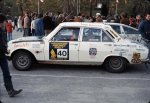
Yes, marathon posting to keep up with the marathon spirit. I was swimming in Marathon beach earlier today as well (really!). The Peking to Paris is not in the cards because we found out that my son Dino (who would be 16 at the time of the rally) is a year too young to cross China according to their regulations. I would love to make it out there for the Classic Outback if the dates work out, Graham, but I think it will make more sense to have a car built there rather than transport one.
Huge congratulations. What a great effort. Wow....
Here are two for you from 1977 on the second London-Sydney Marathon, photographed in Adelaide.
Cheers
- Joined
- Aug 2, 2000
- Messages
- 11,485
Number 40 , Basil Wadmans car, still exists as a very rusty shell at Lara, Vic.
Water got into the foam filling and made a real mess.
The Dunkerton car was reshelled after many more rallies with Bob Watson, culminating with the famous V6 turbo configuration. Don't know what happened to the shell, but no doubt it was crushed.
Water got into the foam filling and made a real mess.
The Dunkerton car was reshelled after many more rallies with Bob Watson, culminating with the famous V6 turbo configuration. Don't know what happened to the shell, but no doubt it was crushed.
View attachment 74358View attachment 74357
Huge congratulations. What a great effort. Wow....
Here are two for you from 1977 on the second London-Sydney Marathon, photographed in Adelaide.
Cheers
Great pics, thanks for those
Sent from my GT-I9506 using Tapatalk
Sent from my GT-I9506 using Tapatalk
Some answers: The adjustable cam sprocket can be made by any moderately skilled machinist. An aluminum disc with oval holes is bolted onto the stock sprocket, then the sprocket is cut into two sections. Take your sprocket and the two attached photos to a machine shop. If it is not immediately obvious to the machinist what needs to be done, go straight to another machine shop.
A six paddle clutch looks like the blue one in the photo. The works Berlines used a solid disc without springs but this makes changes very abrupt and takes a toll on the drive-line, especially the splines. This would be problematic for our engines, especially since they have much higher low end torque than the works engine. The higher torque works V6 coupes used springs to protect the drive-line; a photo of the works parts is also attached.
A six paddle clutch looks like the blue one in the photo. The works Berlines used a solid disc without springs but this makes changes very abrupt and takes a toll on the drive-line, especially the splines. This would be problematic for our engines, especially since they have much higher low end torque than the works engine. The higher torque works V6 coupes used springs to protect the drive-line; a photo of the works parts is also attached.
Attachments
That would be a fun car just to drive in traffic! It looks too good to thrash on rough roads!
That would be a fun car just to drive in traffic! It looks too good to thrash on rough roads!
It was made for rough roads, Mike. It took incredible abuse during the shakedown and all we had to do was wash it. It would be such a big waste to drive it in traffic, you can build a car for a tenth of the cost to do that.
Yeah I know; it just looks so perfect now....
View attachment 74358View attachment 74357
Huge congratulations. What a great effort. Wow....
Here are two for you from 1977 on the second London-Sydney Marathon, photographed in Adelaide.
Cheers
Thank you for the pictures, John, I really enjoyed looking at them. The Dunkerton car seems well set up, the Wadman car seems to be riding on the bump stops. The Long Drive, a book I read about the 1977 London to Sydney marathon is what got me interested in long distance rallying. It was written by John Stathatos, a Greek photojournalist living in London, who participated in a 504; clearly, a combination like that was hard for me to ignore
- Joined
- Aug 2, 2000
- Messages
- 11,485
The Dunkerton car had works suspension, was meant to be have been built by the factory but a strike meant the cars were shipped to London and put together by the drivers, including Ross Dunkerton, Bob Watson, Bob Holden, Roger Bonhomme, ace car builder of the time Gil Davis and I think Dave Bradford. Many long days and nights were spent.
Some of the works parts from these cars are still surviving here in Australia.
I have the build sheet that Bob Holden drew up with advice from the factory, not just suspension, but standard Ti engines were used.
I wouldn't say the event was slow at the pointy end, not with the Mercedes works cars and Zasada in the Porsche.
I'll be taking a look at the winning car next month at the Mercedes museum.
Some of the works parts from these cars are still surviving here in Australia.
I have the build sheet that Bob Holden drew up with advice from the factory, not just suspension, but standard Ti engines were used.
I wouldn't say the event was slow at the pointy end, not with the Mercedes works cars and Zasada in the Porsche.
I'll be taking a look at the winning car next month at the Mercedes museum.
Thank you for the pictures, John, I really enjoyed looking at them. The Dunkerton car seems well set up, the Wadman car seems to be riding on the bump stops. The Long Drive, a book I read about the 1977 London to Sydney marathon is what got me interested in long distance rallying. It was written by John Stathatos, a Greek photojournalist living in London, who participated in a 504; clearly, a combination like that was hard for me to ignore. The book reads like I am sure the marathon felt, long and slow. But the facts are fascinating and Stathatos describes the personalities of the other crews with clinical precision. I can almost see all the types he describes in his book in my own circle of rally drivers. Interestingly enough, he did not like the 504 very much (heavy and slow), especially in the beginning of the event. When the late Philip Young, who was also a participant in the 1977 event, founded the Endurance Rally Association, I kept a close watch on his events with the hope that one day I would participate. Philip was a strong advocate for the 504, he had one himself. When we met in 2012 as his London to Cape Town rally was passing through Greece (with five 504's in the entries), he was really impressed by my 504's. "You need to enter the 2016 P2P rally, time to show the world what a well prepared and driven 504 can do." And so the quest started, but the target is now the 2019 event.
...I wouldn't say the event was slow at the pointy end, not with the Mercedes works cars and Zasada in the Porsche....
For sure, Graham; I was referring to Stathatos' 504, which he described as slow. He also described some of the questionable tactics by Zasada and the Mercedes works team as an indication of what it took to be fast in that event.
Do you still have it? The factory sheet also indicates standard Ti engines (they picked the more powerful ones from the litter), although they used Safari spec suspension and many other Safari parts.I have the build sheet that Bob Holden drew up with advice from the factory, not just suspension, but standard Ti engines were used...
The following listing is from the Sochaux factory and includes period [1976?] pricing. I have tabulated the items to read more easily.
Rally car preparation
The 504 Ti is considered as the most suit*able version to form the basis on which to develop a marathon rally car. The engine in standard form develops 106 bhp maximum, using the well proven Kugelfischer fuel injection which has showed itself to be a most reliable system in service.
The factory at Sochaux has made special provision for the preparation of the bodies to rally requirements. This takes the form of additional fabrication in specific areas, eg roll cage reinforcements, wing valances in thicker steel, double skinned front members, extra welding, etc. The lead time for this preparation in normally in the region of three months. Such work can be carried out for any serious competitor and the whole package will include the following:
1. Reinforced body
2. Selected engine from production capable of around 110 bhp
3. Differential from carburettor version (9 x35 in place of 9 x 34)
4. Reinforced suspension (standard African spec.)
Total cost: FF 10,000 plus price of the standard Ti model.
In addition to the basic unit, further items are available, listed as follows. We can also provide a good deal of other information and suggestions which have been developed from our highly successful works competition team.
This total package will provide any rally team with a very competitive vehicle, capable of long distance durability and proven reliability.
| Reinforced for rallying | FF | £ |
| 2 front suspension legs | 2,700 ea | 349.41 ea |
| Rear shock absorbers | 1,366ea | 176.71 ea |
| Rear springs | 270 ea | 34.94 ea |
| Special steering rack (PAS type, smaller turning circle) LHD only | 1,270 | 164.35 |
| Clutch disk (metal type) | 725 | 93.75 |
| Hypoid Diff with limited slip (ratio 8 x 37 + 170 kph @ 7,000 rpm) | 2,700 | 349.41 |
| Engine and gearbox protector | 1,790 | 231.65 |
| Diff protector | 1,350 | 174.71 |
| Gearbox - close ratio | 13,000 | 1,682.35 |
| Safety fuel tank (100 litre) | 3,500 | 452.94 |
| Roll cage - Devil | ? | ? |
Other items which are modified or adapted:
· Straight through exhaust system manufactured by Chretien
· Special uprated engine mounts and stabilizer bars
· Guard for the clutch slave cylinder
· Radiator repositioned 15mm forwards
· Rear bump stops moved to act on the middle of the rear suspension arms
· Rear cross member completely locked up
· Special rapid-fill tube for the gearbox
· Internal control for the cooling fan, additional to the thermo sensing switch Bracing bar between the tops of the front suspension mounts
Twin alternators and circuitry with snap connectors (one for standby)
· Twin coils with snap connectors
· Rubber cover for distributor
· All chassis bolts under the car have double nuts for thread protection
· Oil filter flange bolts wired for safety
· Brake compensator without the control arm but can be adjusted
· Flexible pipe between clutch and master and slave cylinder.
· Clutch slave cylinder circlip locked with wire
· Spacer flange for the sump to increase oil capacity
· Flexible brake hoses protected with tape
· Special plate to protect diff. and diff. extension
· Asbestos wrapping around R/H brake cable to protect from exhaust heat
· Inlet manifold plenum chamber made of fibre glass
· Electronic ignition control box mounted under the dash inside car on navigator's side
· Navigator has additional foot control for screen washers with large capacity reservoir and two twin water jets
· Front anti-roll bar with nylon bushes
· Safety fuel tank in boot with three fuel pumps and special rapid fill, anti spill
fuel funnel
· Radiator cap with security wire to prevent accidental loss also special engine-oil fill*er cap on the rocker cover similarly wired
· Headlamps fixed solidly into position to eliminate vibration
· Inspection plates over the tops of rear suspension mounts for quick access
· Special frame in rear to locate two spare wheels and triangular sections on the inside of the rear doors to act as retainers.
Last edited:
